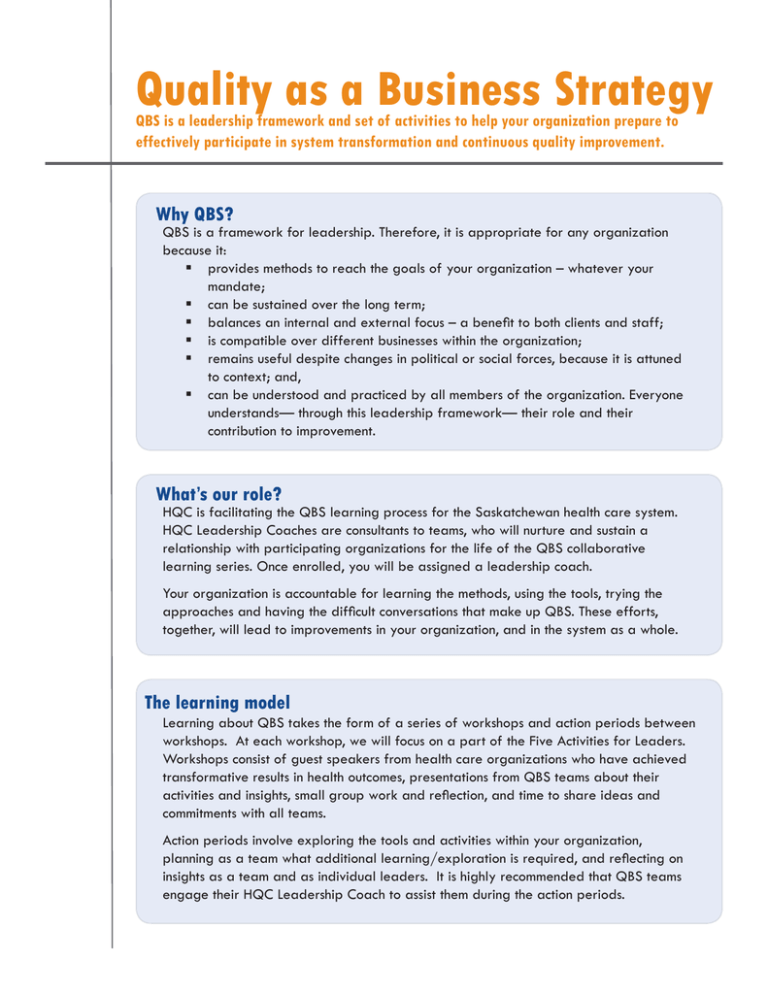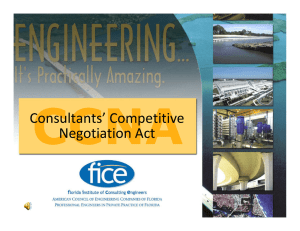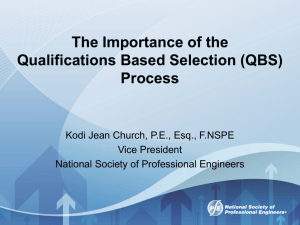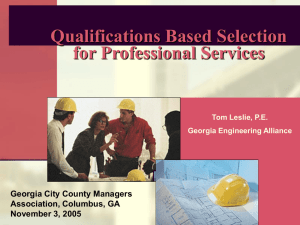Quality as a Business Strategy: Leadership Framework
advertisement

Quality as a Business Strategy QBS is a leadership framework and set of activities to help your organization prepare to effectively participate in system transformation and continuous quality improvement. Why QBS? QBS is a framework for leadership. Therefore, it is appropriate for any organization because it: provides methods to reach the goals of your organization – whatever your mandate; can be sustained over the long term; balances an internal and external focus – a benefit to both clients and staff; is compatible over different businesses within the organization; remains useful despite changes in political or social forces, because it is attuned to context; and, can be understood and practiced by all members of the organization. Everyone understands— through this leadership framework— their role and their contribution to improvement. What’s our role? HQC is facilitating the QBS learning process for the Saskatchewan health care system. HQC Leadership Coaches are consultants to teams, who will nurture and sustain a relationship with participating organizations for the life of the QBS collaborative learning series. Once enrolled, you will be assigned a leadership coach. Your organization is accountable for learning the methods, using the tools, trying the approaches and having the difficult conversations that make up QBS. These efforts, together, will lead to improvements in your organization, and in the system as a whole. The learning model Learning about QBS takes the form of a series of workshops and action periods between workshops. At each workshop, we will focus on a part of the Five Activities for Leaders. Workshops consist of guest speakers from health care organizations who have achieved transformative results in health outcomes, presentations from QBS teams about their activities and insights, small group work and reflection, and time to share ideas and commitments with all teams. Action periods involve exploring the tools and activities within your organization, planning as a team what additional learning/exploration is required, and reflecting on insights as a team and as individual leaders. It is highly recommended that QBS teams engage their HQC Leadership Coach to assist them during the action periods. How was QBS developed? W.E. Deming believed that an organization should operate as a system that is designed to meet the present and future needs of its stakeholders—who Deming describes as “the customers”. The organization Deming envisioned—that can continuously match customer needs and wants with service delivery—requires a new style of management, as well as new philosophies, knowledge, and methods. Deming taught his philosophy and approach to leading for continuous improvement in a series of executive workshops in Japan in the 1950s and in the US in the 1980s with the help of 5 men who came together to create Associates for Process Improvement (API). In 1985, Associates in Process Improvement began developing the QBS framework to help organizations incorporate Deming’s philosophy and concepts into their management practices. The QBS framework is not simply installed or implemented in an organization, as you would a new computer system. QBS involves learning to see “how every system is perfectly designed to get the results it gets”, and taking actions to redesign the system to perfectly achieve better results for the customers it serves. Leading for Quality Five Activities for Leaders n Establish and communicate purpose of organization o View the organization as a system p Design & manage system for gathering information to improve q Plan for improvement integrated with business planning r Manage individual and team improvement activities n Establish and communicate purpose of organization Why are we here? Who do we serve and what do they need? Unless we spend time – as a leadership team – thinking explicitly about our purpose, it is very likely that our purpose is: • Unclear, and therefore of little use in helping us make strategic decisions; or, • Different for each person in the organization, leading to wasted efforts and dysfunctional work relationships; or, • Not necessarily a match with our vision, what we hope to do, or – most importantly – what our clients need. o View the organization as a system What are our processes? How do they link together? How do we connect with systems outside of our own organization? If we don’t view our organization as a system, we will likely: • Continue to experience the same issues and frustrations, and develop workarounds/policies that fail to create meaningful change; and, • Unwittingly created a disjointed, confusing, and frustrating experience for our clients. p Design & manage system for gathering information to improve We tend to focus on data related to finances and activity. We tend to miss out on information related to outcomes and the voice of the client. Without having a system to gather information for improvement, it is likely that we will: • Create a system that responds to complaints rather than design a system that responds to client needs. • Have a limited understanding of how our investment – in time, people, and resources – is impacting our strategic goals. • Have information on various parts of the system, but no idea how well the parts are working together. q Plan for improvement integrated with business planning Unless we integrate planning for improvement with our strategic/operational planning: • Improvement will continue to be done project by project, but fall short of creating transformative change; • Improvement will continue to be done “off the side of the desk”, reducing the chances of a project being successful; • Improvement may have short term success, but struggle with sustaining changes or spreading good ideas; or, • We will choose to pursue improvements that have little impact on our overall goals. r Manage individual and team improvement activities Without methods, training, and resources to guide the continuous improvement work: • Staff may have difficulty accessing knowledge/skills they need to carry out the improvements; • Efforts will be scattered, with each individual using the most comfortable, but not necessarily the most effective, approach to improvement; • Improvement will be a “lone ranger” activity, with individuals/teams engaged in various projects, but without systems for continuous feedback loops to guide progress; and, • Improvement may be stunted by processes, with little flexibility in the organization to adapt. Adapted from “Quality as a Business Strategy: Building a System of Improvement”, October 1999, Associates in Process Improvement Timeline:Wherewe’vebeen Quality as a Business Strategy Learning Collaborative LW1 LW2 (Orientation) (Voice of Customer) October 2008 January 2009 LW3 LW4 LW5 (Purpose) s tp (Purpose) (Systems) (Measuring) April 2009 June 2009 ed LW3 on Po Connecting the Dots September 2009 System Purpose January 2010 Surgical Experience Provincial Initiatives “Our experience with QBS has been that it accelerates the pace at which organizations improve and reduces the chance that improvement will be a short lived experience.” API, preface









